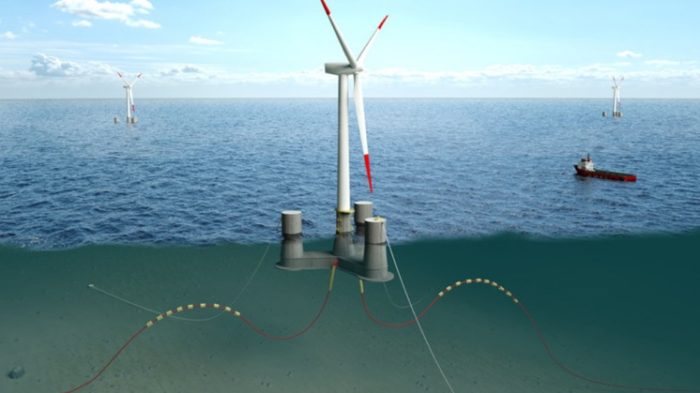Oct 24 2022
Floating Wind Farms
 In the race to decarbonize our energy infrastructure as fast as possible, renewable energy gets most of the attention. This is will good reason – wind and solar are the cheapest new energy capacity to install, with solar beating out wind. But of course, as I have discussed before, we have to look at the whole energy infrastructure picture, not just the cost of installation. There are advantages and disadvantages to all forms of energy. Right now I think it is reasonable to prioritize energy with the lowest carbon footprint, but we cannot ignore other factors.
In the race to decarbonize our energy infrastructure as fast as possible, renewable energy gets most of the attention. This is will good reason – wind and solar are the cheapest new energy capacity to install, with solar beating out wind. But of course, as I have discussed before, we have to look at the whole energy infrastructure picture, not just the cost of installation. There are advantages and disadvantages to all forms of energy. Right now I think it is reasonable to prioritize energy with the lowest carbon footprint, but we cannot ignore other factors.
The primary disadvantage of wind and solar is that they are intermittent. We need some on-demand energy as well, which for non-fossil fuel sources includes grid storage, hydroelectric, nuclear, and geothermal. For wind and solar we also want to choose locations and amounts that have the least environmental impact and are the most functional for each power grid. We could not, for example, have 100% solar at this time, even though solar (when considered in isolation) is cheapest. This because the sun only shines during the day (when it’s not too cloudy) and it would take massive grid storage to shift all solar production to when it was needed.
While wind often plays second-fiddle to solar in terms of renewable energy, it has some significant advantages, and makes a good combination with solar. While wind is also intermittent, it is not as limited to a specific time of day like solar. The wind blows at night, and not all of the place at the same time. With enough wind capacity spread over a large enough area, it may literally be true that the wind is always blowing somewhere.
With wind, the key is location. The ideal location for a wind turbine is somewhere that is not disruptive to the environment, and also with high steady winds. Perhaps the largest environmental impact of wind turbines, if they are placed in the wrong location, is on winged creatures. Early on little attention was paid to this factor, and some poor locations were chosen. Although statistically wind turbines are a tiny factor on bird populations, we would not want to place them in the flight path of raptors. The impact of wind turbines on people is still somewhat debated, but the evidence shows that there is some, but low, plausibility to any health effects and no clear evidence of any actual negative effects, which are mostly subjective. Still, avoiding populated locations avoids political opposition based on these concerns, or aesthetic concerns.
All of these factors make offshore wind ideal. They can be place far away from bird or bat routes, far from any homes, and wind power is greater offshore. For these reasons, offshore wind is now a focus of new capacity. However, there is a major downside to offshore wind – they are more expensive to install. Also, they can only be installed in locations where the water is relatively shallow, about 100 meters or less, and the seafloor is not too complex. Essentially the wind turbines sit on top of a platform that is resting on the sea floor.
In recent years, however, companies have been developing floating offshore wind turbines. This may seem difficult given that turbines have to stay still in the face of strong winds so that the blades will translate as much of the energy as possible into power. Also, wind turbines are tall, and it seems like they would tip over from strong wind. However, designing a floating wind turbine is just a matter of physics, and there are now several workable designs. Essentially you have to displace enough water to float the whole apparatus, and the weight needs to be distributed so that the platform stays upright and is very stable. The platforms are then anchored to the sea floor with heavy weights, and connected with cables to substations that bring their power to where it is needed.
The advantage of floating wind turbines is that they are cheaper because they don’t need a massive platform, they can be build on shore (again, cheaper) and then moved to their working location, and there are many more options where they can be placed. In some locations, the sea floor drops quickly, which does not allow for standard offshore wind installations. But floating wind turbines can work. The UK, for example, has installed five turbines ten miles off the coast of Aberdeen in Scotland, in the North Sea. This location could not work for standard offshore wind.
Since the wind is generally stronger in such locations, wind turbines function more efficiently, and so each turbine will generate more power than a similar onshore turbine.
This technology is just one slice of the overall effort to shift our energy production to a lower carbon footprint, but it could prove significant. I don’t think there is any one solution to our energy infrastructure issues. The best approach to getting rid of fossil fuel is to exploit the best of various options. Put wind and solar where they work the best – pick all the low-hanging fruit, as I like to say. Let the different strengths and weaknesses of each option complement each other. The more options we have, the better we can design the overall infrastructure.






